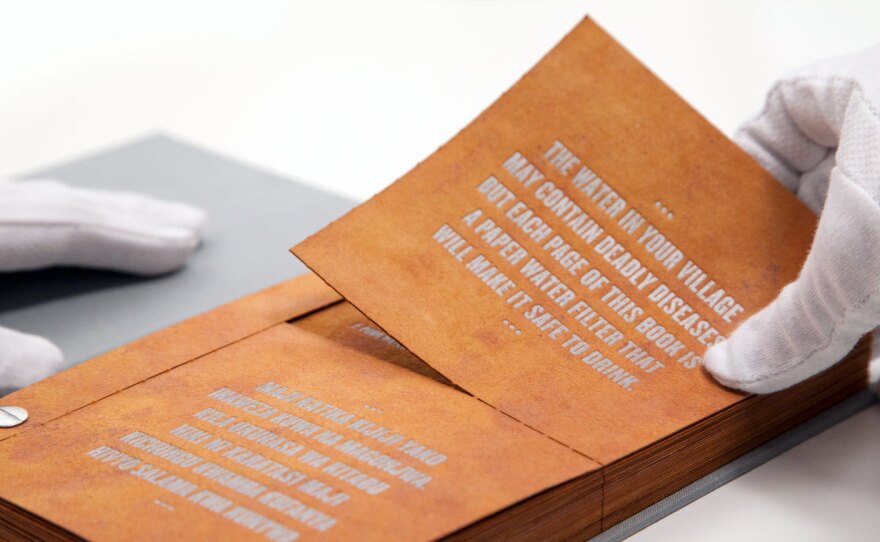It looks like a regular hardcover book, though in an eye-catching shade of orange with an even catchier title: The Drinkable Book.
But it's definitely not your typical book. There are messages on each page about water safety, printed in nontoxic ink, but it doesn't matter whether you read them or not. Each page is divided in half and perforated, designed to be ripped out. In every half page there's a thick filter infused with silver and copper nanoparticles. They give the paper its orange color and, more important, filter out the disease-causing bacteria ubiquitous in the waters of developing nations.
At the national meeting of the American Chemical Society this week, the book's developer, Theresa Dankovich, described field trials in Africa and Bangladesh. Testing highly contaminated samples — for example, from an irrigation ditch next to an elementary school where raw sewage had been dumped — the filter resulted in water that was 99.9 percent pure.
When people in a community in Bangladesh peeked through a microscope at water teeming with bacteria, they had a glimpse into what was making some of their community members sick. When they looked again, after the water had trickled through a page of the book, they saw clear, pristine water. "One woman said, 'If my husband doesn't want to buy it, I would write poetry and sell it so I could buy it myself,' " says Dankovich, a postdoctoral researcher at Carnegie Mellon University.
In the developing world, 1.8 million people, most of them children, die from diarrheal diseases and 88 percent of those diseases are caused by unsafe drinking water and inadequate sanitation and hygiene, according to the World Health Organization. In 2015, 663 million people around the world still don't have access to clean, safe drinking water, according to a report by WHO and UNICEF.
The Drinkable Book, still in development, is one potential answer. "We aim to make it superaffordable," says Dankovich. "We're hoping that each filter will be used for a few days, or a couple of weeks, and then replaced. There are a lot of filters out there, but they often require a pump or power." So far, field tests have shown that the book pages can filter out bacteria in local water supplies in Bangladesh, Ghana, Haiti and South Africa.
It originally took Dankovich 60 hours to make 50 Drinkable Books by hand, saturating each page with an antimicrobial formula and waiting for it to dry, so the next step is to speed up production to ensure the cost will be pennies per filter. A technical problem is to develop a way to let users know when the filter should be replaced. Still ahead: more real-world testing to see how people living in communities without safe drinking water accept and actually use the filter. "We hope to do field tests, day in and day out, starting with a couple of villages in one or two countries," Dankovich says.
An inexpensive water-filtering book could be an improvement over currently available methods, says Thomas Clasen, professor of environmental health at the Rollins School of Public Health at Emory University. "What you need to do is make it as easy and cheap and universal in the community as possible so that the people will adopt it, embrace it, and use it all the time," he says. Clasen has evaluated household water filtration in 20 countries, most recently in India. Boiling water works, but smoke from the indoor fire can cause pneumonia and other diseases as a result of air pollution. Chlorine tablets sanitize water reasonably well, "if you can get people to drink it," Clasen says. "For a population not accustomed to drinking water with chlorine, it's like drinking pool water."
And once sanitized, the water has to be kept clean and protected — away from trash, animals and other contaminants — until used. "The evidence is clear," says Clasen. "You have to protect the quality of the water. In these hygienically challenged places, people aren't washing their hands because there isn't enough water; they store water in open containers and there are animals in the environment. There are all kinds of potential sources for fecal recontamination in the home."
An effective, cheap water filter is a good step, but only a stopgap, says Clasen. "When we sit down and talk to people in these communities, what they really want is accessible water 24/7," he says. Women and children, almost exclusively responsible for getting water, can spend hours every day going to rivers or ponds to fill jerry cans or waiting in long lines at the community tap just for enough water to cook with and drink. Water for handwashing and bathing could mean more time collecting water — time the women can't afford, "which is why hygiene is so challenging," he says. "You can talk to them about filters or chlorine or boiling, and they'll nod and agree. But their main priority is quantity. Filters are important temporary fixes. But in the long term, we've got to improve water quantity and access. That means bringing water directly into households."
Until that day comes for every household in the world, people will need the tools and the education — perhaps written in nontoxic ink on ripped-out pages of a book — to make their water safe.
Copyright 2015 NPR. To see more, visit http://www.npr.org/.






